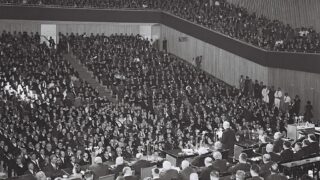Summarized and edited by Assafir Al-Arabi
In the mid-1980s, the Israeli economy underwent a dramatic debt crisis and inflation, the response to which triggered a profound change in the country’s economic regime. Israel’s neoliberal turn, as it became known, led the government to abandon its policy of direct intervention in favor of deregulation, liberalization and privatization. Despite being a global trend, Israel’s road to neoliberalism has had its unique features. From the 2000s the neoliberal turn became particularly extreme. Research shows that during the 2000s Israeli poverty and inequality rates in disposable incomes increased and are very high in comparison to other developed countries.
In the summer of 2011, Israelis took to the streets in a wave of social protest. At the same time, Israel’s hi-tech industry and other export sectors flourished, turning Israel into a country with a large surplus on the current account of the balance of payments. The so-called “Israeli miracle” also manifested itself in a large number of economic indicators such as low public debt, high level of foreign exchange reserves and high credit rating. So how can these unique features of Israeli neoliberalism be explained?
Krampf answers that one explanation is that Israel adopted policy “best practices” of developed countries that were justified on the basis of mainstream economic theories and promoted by professional economists and international institutions… Another explanation is that Israel adopted neoliberal and neoconservative ideologies, imported from the United States, due to external political and economic pressure. Moreover, there is evidence that since the 1990s and especially the early 2000s, Benjamin Netanyahu, as finance minister and prime minister, played a leading role in introducing neoliberal policies, which were often justified by neoconservative ideology.
Another popular explanation for the embrace of neoliberalism in Israel are the interests of a small number of powerful actors in the private sector–the “tycoons”–who cultivated links with the government. As the biggest beneficiary of the privatization and globalization of the Israeli economy is supposedly the private sector, this sector pushed for change. But this explanation is not satisfactory either.
It Is Not Just About Gaza and Palestine
18-01-2025
Israel’s economic history, Krampf continues, demonstrates that structural changes in the economy were initiated first and foremost by the state, which granted benefits to the private sector so that it would not stand in the government’s way but would rather join forces with it. Moreover, the private sector is not a uniform bloc but a mélange of conflicting interests: While the high-tech sector and exporters benefit from the current economic system, many industries and services are adversely affected and seek to change it. So, why did the interests of the former take precedence over those of the latter? The various explanations offered are no doubt important for understanding why the extreme neoliberal model took root in Israel, but they do not provide a complete picture of the historic process.
The elephant in the room
In his article, Krampf argues that what is missing is taking into account a big elephant in the room which has been largely neglected in research and public discourse to date: the link between neoliberalism and the hawkish foreign policy of Israeli governments. The article argues that the hawkish stance of Israel’s right-wing governments over the past decade and a half were the incentive for embracing a specific type of neoliberal model he calls ‘hawkish neoliberalism’, associated with higher levels of inequality and poverty compared to alternative neoliberal models.
To understand Israel’s transition from one neoliberal system to the other, one must understand the geopolitical conditions underlying the choices made by Israeli policymakers. A government guided by a hawkish foreign policy or plagued by security issues will have an added incentive to adopt hawkish neoliberal policies as an alternative to a heavy reliance on international accords and foreign aid.
As long as Israeli and American interests coincided, American aid was not perceived by Israeli governments as a threat to its sovereignty and autonomy. In the second half of the 1970s and the 1980s, American interests in the Middle East changed, with the US seeking to establish itself as a mediator between the Arab states and Israel. The Americans began exerting soft pressure on Israel to adopt a more dovish foreign policy.
The argument in favor of hawkish neoliberalism is twofold. One rationale in Israel is that radical measures must be taken to fortify Israel’s geopolitical and economic resilience amid security threats. Within this conception higher levels of inequality and poverty are perceived as being the cost of Israel’s security conditions. The second incentive, which rounds out the first and is rarely cited in scholarship or public discourse, is that the hawkish neoliberal model, promoted mainly by Israel’s right-wing governments, is designed to reduce Israel’s economic dependency on outside agents - first and foremost, the United States and to a smaller degree, European countries - for political reasons. Cutting down Israel’s dependence on foreign aid means that foreign governments will have less power to influence Israel’s political decisions in such matters as peace negotiations or Israel’s handling of the occupied territories.
Two types of neoliberalism
The economist then asks, how is neoliberal radicalization linked to the attempts of Israeli governments in recent years to fortify its de-facto sovereignty? Krampf goes on to explain that the term neoliberalism can be better understood by distinguishing between two different models of economic neoliberalism: what he calls the European–or cosmopolitan–neoliberal model, and the Anglo-American–or hawkish–model.
The first prioritizes liberalization of the domestic economy as well as international trade and capital flows, while ascribing importance to market-oriented regulation, including regulation of workers’ rights, allowing for varying levels of social welfare policies. In contrast, the Anglo-American neoliberal model was based on the “business-friendly policy” approach, which was implemented at the expense of the welfare state and dealt a significant blow to the power of the workers. In terms of foreign relations, Anglo-American neoliberalism is more “isolationist”, in the sense that it does not advocate multilateralism and international cooperation.
Many semi-peripheral countries, including Israel, were influenced by the neoliberal models of the United States and Europe, even if they did not adopt them blindly. From the perspective of a small economy, the global economy is perceived as a battleground in which countries engage in combat through economic means. Under export-oriented neoliberalism, the central goal of the government is not primarily to boost growth and the citizens’ welfare but rather to upgrade the position of the economy in the international arena... The purpose of this policy is to improve the current account balance–reducing the deficit or increasing the surplus–attracting direct foreign investment, slashing the public external debt and the hoarding of foreign reserves by the central bank.
According to Arie Krampf, this policy improves Israel’s ability to withstand economic and political shocks by relying on its own resources. A second advantage, which stems from the first, is political. The strategy of self-reliance undermines the capacity of external actors– the international community, political allies or international organizations– to influence the policymaking process of the government. In that sense, a hawkish neoliberal regime contributes to the government’s autonomy vis-à-vis external actors and to its de-facto sovereignty in a globalized world.
Israeli dependence and sovereignty
In his paper, Arie Krampf argues that the two types of neoliberalism presented here align with two periods in Israel’s economic history since the onset of the neoliberal turn: From 1985 to 1995, Israel was characterized by a cosmopolitan, or dovish, neoliberalism. From the early 2000s and until today, Israel has been characterized by hawkish neoliberalism. In order to understand Israel’s transition from one to the other, it is not sufficient to examine the economic pros and cons of each regime. Rather one must understand the geopolitical conditions underlying the choices made by Israeli policymakers.
A government guided by a hawkish foreign policy or plagued by security issues will have an added incentive to adopt hawkish neoliberal policies as an alternative to a heavy reliance on international accords and foreign aid, Krampf says. If successful, this regime acts as a kind of economic and political shock-absorber, and helps to exclude outsiders from exercising influence over the local decision-making process. In Israel, economic and geopolitical conditions have made “economic independence” a critical policy objective since its establishment.
Krampf provides an example: after the Six-Day War, and even more so after the October War, the urgency of narrowing the trade-deficit diminished in Israel as the United States began to provide substantial economic, military and civilian aid. This aid led to a significant increase in government expenditure. It footed the bill for an army befitting a regional power, a European-scale welfare system, generous support for industrialists and exporters, and the costs of administering the occupied territories. The cost of these achievements was a growing economic and political reliance on US economic and military aid. As long as Israeli and American interests coincided, American aid was not perceived by Israeli governments as a threat to its sovereignty and autonomy.
However, in the second half of the 1970s and the 1980s, American interests in the Middle East changed, with the United States seeking to establish itself as a mediator between the Arab states and Israel. The Americans began exerting soft pressure on Israel to adopt a more dovish foreign policy. This led to the signing of the peace treaty with Egypt in 1979... When the Israeli economy was on the verge of collapse in 1985, Israel was rescued by American aid, on the condition of adopting the Emergency Economic Stabilization Plan.
Peres saw markets as a pacifying instrument, from which the private sector on both sides would reap dividends. The peace envisioned at Oslo enjoyed broad support from the local business sector, which anticipated profits in the wake of economic cooperation with Jordan and the Palestinian Authority. International companies also began to show an interest. In this respect, the paradigm of the New Middle East derived its inspiration from European neoliberalism and the European integration process.
The outbreak of the Second Intifada, accompanied by the collapse of the Oslo framework, marked the end of Israel’s dovish neoliberal era. As the catchphrase “there is no partner” gained a foothold in the public discourse, the optimism that underlay Peres’ vision of the New Middle East was replaced by the outlook that the necessary prerequisites for this vision were non-existent. In this new configuration, achieving economic self-reliance regained importance in the eyes of the political leadership.
Thus began the age of dovish neoliberalism in Israel - an era of liberalization along with the advancement of the peace process and hopes for regional and international cooperation. Under these circumstances, economic dependence on the United States was not seen as exacting a high political cost. In the 1980s and 1990s, American aid was perceived as part of a political- economic exchange between the United States and Israel. Israel was moving the peace process forward in keeping with American interests and applying a neoliberal economic policy that conformed to the American worldview. In return, it received economic backing.
The cosmopolitan neoliberal regime was justified on the basis of a rationale formulated by Shimon Peres. In his book ‘The New Middle East’, he writes that the countries of the Middle East “have lost every need for war, as the development of a modern economy depends more on a nation’s technological level than on its territory. It is also cheaper to acquire natural resources with money than with weapons, at an economic price rather than at a price derived from war. Secondly, the price of war (and any big war in the future will be in the shadow of nuclear weapons) makes such behavior exceedingly unreasonable.”
Peres saw markets as a pacifying instrument, from which the private sector on both sides would reap dividends. Indeed, the peace envisioned at Oslo enjoyed broad support from the local business sector, which anticipated profits in the wake of economic cooperation with Jordan and the Palestinian Authority. International companies also began to show an interest. In this respect, the paradigm of the New Middle East derived its inspiration from European neoliberalism and the European integration process.
As a small economy, Israel’s structural reliance on exports and imports may expose it to potential political pressure levers such as boycotts or the withdrawal of benefits for Israeli export, which is the type of action called for by the BDS movement.
Israel has not reached complete autonomy vis-à-vis the US. The dependence of Israel on US diplomatic, military and technological direct and indirect support is an essential element in Israel’s historical path. However, the question is not whether Israel is dependent or not on US support. Rather, the question is to what extent the US support to Israel enables it to influence Israel’s choices in the area of foreign policy and national security.
Under this vision of the New Middle East, economic self-reliance became less of a strategic priority. First, within the framework of cosmopolitan neoliberalism, trade deficits are seen not as a problem but as the natural and harmless byproduct of a free global economy. Therefore, the government had no incentive to strive for a current account surplus. Second, given that Israel and the United States had a common regional vision, the government could trust America to foot the bill for its peace efforts. The cost of achieving economic self-reliance thus outweighed the expected benefits.
The outbreak of the Second Intifada, accompanied by the collapse of the Oslo framework, marked the end of Israel’s dovish neoliberal era. As the catchphrase “there is no partner” gained a foothold in the public discourse, the optimism that underlay Peres’ vision of the New Middle East was replaced by the outlook that the necessary prerequisites for the realization of this vision were non-existent. In this new configuration, achieving economic self-reliance regained importance in the eyes of the political leadership.
Giving up foreign aid?
Krampf concluded that whatever aid is forthcoming provides the Americans with a swift and easy means of intervention in Israeli decision-making. Thus Israel’s hawkish economic strategy has effectively limited – but not eliminated, of course – the power of the American administration to bend Israel’s arm in matters of foreign and defense policy.
Indeed, from 1997, civilian aid to Israel, some $1.2 billion a year, gradually decreased and came to an end in 2008. However, the Israeli government was not prepared to turn down military aid, which has only increased over the years ($3 billion a year and swelling following an agreement between Netanyahu and Obama). The fact that the actual scope of US aid has not diminished would seem to undermine the central argument presented by Krampf. However, he points that it should be borne in mind that the extent to which a donor country can exert pressure on the recipient country does not depend only on the amount transferred but also on the extent to which the recipient country is capable of relinquishing it.
This is not to say that Israel has reached a full and complete autonomy vis-à-vis the US. The dependence of Israel on US diplomatic, military and technological direct and indirect support is an essential element in Israel’s historical path. However, the question is not whether Israel is dependent or not on US support. Rather, the question is to what extent the US support to Israel enables it to influence Israel’s preferences and choices in the area of foreign policy and national security.
In order to encourage exports, the Israeli government provides concessions and privileges to a small number of large companies, mainly in the High-Tech sector. This policy has strengthened the trend of export concentration: Most of Israel’s exports revolve around a few High-Tech companies which enjoy massive government support.
In 2007, Israel’s ten largest exporters accounted for 36% of its total exports; in 2014, their share increased to 50% of total exports. In 2010, four companies - Teva, Israel Chemicals, Intel and Check Point - which accounted for 0.5% of commercial operations in Israel - received tax breaks of $4 billion.
During his term as minister of the economy, Naftali Bennett was one of the leading promoters of hawkish neoliberalism in Israel and made an effort to attract investors and boost exports, especially to non-Western countries in East Asia, Africa and Latin America. Bennett’s economic autonomy approach considers that Israeli exports provide an attractive basis for establishing conflict-bypassing alliances.
One may argue that export-oriented growth only deepens Israel’s reliance on foreign actors, exposing it to potential political pressure levers such as boycotts or the withdrawal of benefits for Israeli export, which is the type of action called for by the BDS movement. The hawkish model, Krampf argues, deals better with such issues than the cosmopolitan model. It does not rely on “fair” trade conditions, but on the upgraded global competitiveness of Israeli firms, less dependence on foreign aid and loans, and powerful financial shock absorbers. These advantages (for Israel) of the hawkish neoliberal regime compensate not only for the security risks faced by the Israeli economy, but also for the political risks associated with Israel’s hawkish foreign policy.
Conclusions
The success of Israel’s hawkish neoliberal regime is largely measured by economic variables that reflect its relations with the rest of the world. Available figures indicate that Israel is equipped to withstand political or economic shocks without requiring aid from external actors. Hence, one would think that we are talking about a simple story of “economic success”. However, the isolationist model adopted by Israel takes a heavy and particularly extreme social toll on a large proportion of the Israelis.
Overall, 90% of the total tax breaks went to a quarter of the companies in the top size decile. This policy had regressive social repercussions, as it gives priority not only to companies that export, but also workers in this specific sector. The gap between export industries, characterized by high production productivity and high wages, and local production industries, characterized by low production productivity and low wages, has grown significantly over the last two decades, according to experts.
In order to encourage exports, the Israeli government provides concessions and privileges to a small number of large companies, mainly in the High-Tech sector. This policy has strengthened the trend of export concentration: Most of Israel’s exports revolve around a few High-Tech companies which enjoy massive government support. In 2007, Israel’s ten largest exporters accounted for 36% of its total exports; in 2014, their share increased to 50% of total exports. In 2010, four companies - Teva, Israel Chemicals, Intel and Check Point - which accounted for 0.5% of commercial operations in Israel - received tax breaks of $4 billion, which came to 70% of the total tax breaks granted that year and about half of the surplus in Israel’s current account[1].
Overall, 90% of the total tax breaks went to a quarter of the companies in the top size decile. This policy had regressive social repercussions, as it gives priority not only to companies that export, but also workers in this specific sector. The gap between export industries and local production industries has widened significantly. This means that a small group of industrialists and workers in Israel enjoy economic prosperity, leaving all the other sectors behind.
In addition, the Bank of Israel’s dollar purchasing policy, which is typical of the hawkish model, has led to a rise in domestic prices. This policy preserves a lower shekel exchange rate than would be expected without the Bank’s intervention, thereby providing an incentive for exporters. At the same time, it raises import prices and increases the cost of living. This adversely impacts the real wages of workers (of the lower and middle class), meaning Israel’s citizens are subsidizing Israeli export, without receiving generous welfare that might compensate their losses.
Arie Krampf finally wonders whether the hawkish neoliberal model was imposed on Israel due to what he calls its “unique security conditions in the Middle East” or whether it was a political or ideological choice. The writer concludes that it is undeniable that the capacity of Israel to embrace and imitate the European model of cosmopolitan neoliberalism is constrained by domestic institutional, political and economic factors that cannot be changed in the short or medium terms. However, he believes it would be a mistake not to recognize the discretionary space of policymakers in which ideological and political factors play a key role in shaping the domestic socio-economic regime in Israel, which promises socio-economic consequences that may arise from Israel’s security choices.
_______________________________
This text is part of a broader research launched in an attempt to follow up on the fundamental statement, “It Is Not Just about Gaza or Palestine,” drafted and published by Assafir Al-Arabi, available on our website in Arabic, French, and English. After the articles, “What Changes Are Taking Place in Dominant Capitalism?” and “Ras El-Hekma: Has Egypt Sold its Land to the UAE?”, we present here “Israel’s Neoliberal Turn and its National Security Paradigm”.
The full text can be downloaded as a PDF from the Library of Science.
______________________________
Arie Krampf is a critical Israeli economist and university professor. This summary is based on a research paper of the same title, published in 2018 in English. The text is relevant to our research, as it touches on the question of the nature of the current Israeli economic and political system and its most significant transformations.
- Krampf, A. (2018). The Israeli Path to Neoliberalism: The State, Continuity and Change. Milton Park, Abingdon, Oxon & New York, NY: Routledge. ↑







